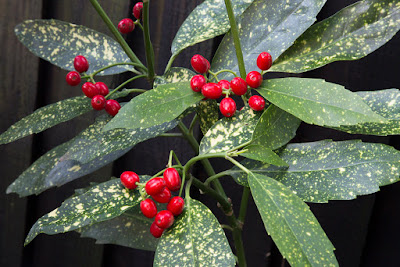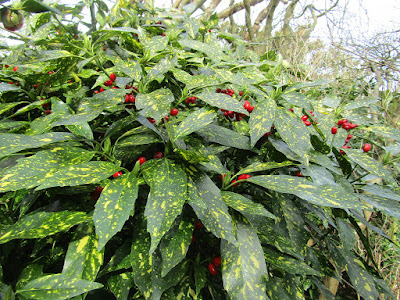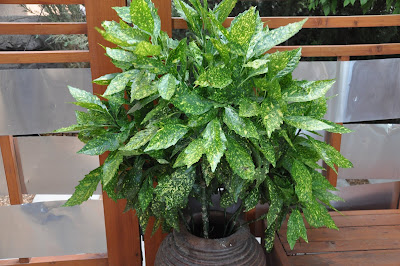Aucuba japonica, spotted laurel, Japanese laurel, Japanese aucuba or gold dust plant, is a compact shrub appreciated for its thick evergreen and decorative foliage, a shiny dark green. Its preference for shady situations makes it an essential subject for garnishing the dark corners of the garden...
Aucuba japonica, spotted laurel, Japanese laurel, Japanese aucuba or gold dust plant, is a compact shrub appreciated for its thick evergreen and decorative foliage, a shiny dark green. Its preference for shady situations makes it an essential subject for garnishing the dark corners of the garden. Robust, rustic, resistant to heat, pollution and diseases, the Japanese aucuba will find its place in all the gardens, but also on a terrace sheltered from the sun for the greatest pleasure of the townsmen!
Aucuba japonica details:
Belonging to the Cornaceae, the genus Aucuba has a few species of shrubs acclaimed for their ability to bloom in the dense shade. They all have large evergreen and decorative leaves, like the Aucuba japonica, the most common species in our gardens. Its ease of cultivation and its hardiness have led breeders to obtain various varieties, foliage sometimes variegated, sometimes speckled, white or yellow.
Aucuba japonica is native to China, Japan and the Himalayas where it grows undergrowth to form a large shrub up to 5 m tall. Its slender stems extend by suckers and marcots then end up forming a dense shrub. Its habit is bushy, rounded and erected. The Aucuba japonica has a lush, dark green foliage with a glazed, leathery appearance. Single leaves, lanceolate, with unevenly serrated edges, can measure more than 20 cm.
In May and June, the Aucuba japonica flowers in red-purple. The shrub then bears tiny flowers, each with 4 petals, organized in clusters at the end of the branches. The flowering is followed by a decorative fructification in the form of small red-bright drupes, which remain on the shrub all winter and create a certain contrast with the foliage. Note, however, that the Japanese aucuba is a dioecious plant; only female plant form fruit, provided they are placed near a male plant. These pretty berries feast the birds, but, just like the foliage, the fruiting of this shrub is toxic in case of ingestion for the human and can cause minor digestive disorders.
Grow and care Aucuba japonica:
The best time to plant Aucuba japonica is March and October, but you can also plant in February to May and September to November. If you grow this shrubs in the open ground, install your Aucuba japonica in a hole about 60cm deep, filled with a mixture of horticultural compost enriched with an organic fertilizer. Add sand if your land is too heavy.
Water the first 2 years of planting regularly in the summer. If you grow this shrubs in pots, make a bed of clay balls or gravel to ensure good drainage. Repot your aucuba with a mixture of horticultural compost and peat to lighten the substrate. In fine weather, water regularly to keep the mound fresh. In winter, take care to allow the soil to dry before making a new supply of water. Fertilize regularly during the growing season.
The Aucuba japonica appreciates shady to slightly sunny situations, cool, fertile, well drained soils with a neutral or slightly acidic tendency. It has good hardiness (-15 ° C), as well as a remarkable resistance to pollution, spray and heat. Once established, this shrubs can withstand short periods of drought without suffering. Supporting the size, it is usable for the formation of a hedge, but also garnishes the back of a massive in free form in city as in the countryside.
In pot it dresses balconies, terraces or courtyards that can provide a little privacy thanks to its dense foliage. Its penchant for shade makes it an ideal shrub to vegetate patios and porches. It blends harmoniously with Bamboos, Cotoneasters or Mahonia. You can also associate it with lower plants that will create a nice contrast. Remarkably disease resistant and easy to maintain, the Aucuba japonica offers a pleasant cultivation facility for gardeners, even the most novices!

















COMMENTS